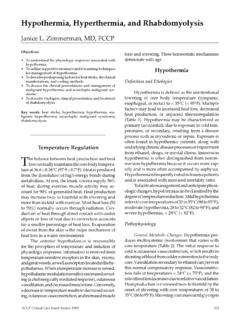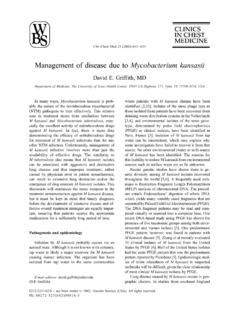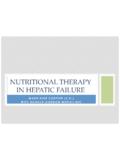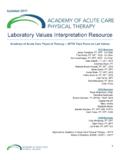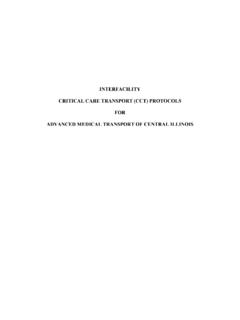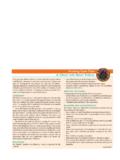Transcription of Management of agitation in the intensive care unit
1 Management of agitation in the intensive care unitMark D. Siegel, MDa,b,*aPulmonary and critical care Section, Yale University School of Medicine, Post Office Box 208057,New Haven, CT 06520-8057, USAbMedical intensive care Unit, Yale-New Haven Hospital, 20 York Street, New Haven, CT 06504, USAA gitation is a frequent, challenging problem inintensive care units (ICUs) and affects at least 71%of patients, both young and old[1 3]. Contributingfactors include underlying illness, pain, anxiety, anddelirium. Dangerous consequences range from poorlytolerated invasive therapy to self-destructive behavior,leading to widespread, sometimes heavy-handed, se-dation[4,5].
2 Patients in the ICU are often too sedated. A recentstudy found that fewer than 5% were agitated whenassessed; this suggested that some sedation is exces-sive or unnecessary[6]. Used inappropriately, seda-tives can impair cognition and depress consciousnessand lead to secondary complications, such as failure towean from mechanical ventilation, prolonged ICUstays, and increased cost of care [7 10]. Conscien-tious clinicians must strike a balance between treatingagitation and avoiding oversedation. This article out-lines a systematic, practical approach to evaluatingagitation and suggests recommendations for safe,effective and causes of agitation in theintensive care unitAgitation is characterized by excess motor activityand is driven by internal factors, such as disease,pain, anxiety, and delirium[11,12].
3 Activity may bepurposeless or, more dangerously, include removing or disconnectingcatheters, self-extubation, ventilator dysynchrony,and increased oxygen consumption[13 18]. Agita-tion may also lead to detrimental long-term outcomesthat range from unpleasant memories to posttraumaticstress disorder, although some investigators have sug-gested an association with treatment, rather than agi-tation itself[19 24].It is tempting, but dangerous, to consider agitationthe natural consequence of critical illness. Similarly, itwould be wrong to sedate patients indiscriminatelywithout considering causes that require specific treat-ment(Box 1) [1,25].
4 Many patients need sedation,particularly those who require mechanical ventilation,but inappropriate or excess sedation can have un-intended consequences[7,8]. In addition to increasedlength of stay and failure to wean from the ventilator,excessively sedated patients can develop prolongedcognitive impairment and delirium. Important prob-lems, such as chest pain, dyspnea, and neurologicchanges, can be missed because patients are difficultto patients need the same type of systematicevaluation applied to problems such as hypotensionand hypoxia.
5 Finding a specific cause may allowdirected, effective treatment (seeBox 1). Potentiallylife-threatening problems such as hypoxia, hypercar-bia, hypoglycemia, and sepsis should be that can be easily corrected, but are oftenmissed because patients cannot communicate, shouldbe sought. Examples include uncomfortable bed posi-tion and dry problem of patient-ventilator dysynchronymerits special attention[15 17]. Potential causes in-clude inadequate or excessive inspiratory flow rates,tidal volumes that are too high or too low, andineffective effort.
6 Inadequate ventilator flow rates can0272-5231/03/$ see front matterD2003 Elsevier Inc. All rights (03)00104-7* Pulmonary and critical care Section, Yale UniversitySchool of Medicine, Post Office Box 208057, New Haven,CT Chest Med 24 (2003) 713 725be readily detected by examining ventilator some patients, simple maneuvers, such as changingthe inspiratory flow rate or tidal volume or usingpressure control, may improve tolerance of mechanicalventilation. Occasionally, however, heavy sedationmay be required for poorly-tolerated mechanical ven-tilation techniques, such as inverse ration ventilationor permissive hypercapnia.
7 Still, medication shouldnever substitute for effective ventilator of agitationCompared with life-threatening problems, such asshock and respiratory failure, the treatment of agitationreceives little attention. A recent systematic reviewfound only 15 prospective, randomized studies thatinvestigated successful sedation as a primary outcomein mechanically-ventilated patients[26].Effectivemanagement, however, in addition to providing com-fort, is indispensable in helping patients tolerate some-times noxious treatments and of nonpharmacologic approachesand treatment of specific medical disorders alwaystakes precedence.
8 Life-threatening problems, such ashypoxia and hypoglycemia, and pain from acute dis-eases, such as myocardial infarction, require promptattention. Non life-threatening problems, such asfear, inability to communicate, and uncomfortablebed position, may respond to simple interventions,such as reassurance, a writing board, and reposition-ing. General approaches that may promote comfortinclude music therapy and hypnosis, although theeffectiveness of these interventions requires furtherstudy[27,28]. Even when medication is required,nonpharmacologic interventions can be usefuladjuncts to allow lower dosages of , anxiety, and delirium are the most commoncauses of agitation that require medication[1].
9 Itiscritical to distinguish among them because eachrequires specific treatment with analgesics, anxio-lytics, or antipsychotics, alone or in failure to identify these problems, particularlypain and delirium, can result in missed opportunitiesfor effective treatment. Some patients become with-drawn rather than agitated but still need should be used judiciously and thought-fully and never as a nonspecific chemical restraint. Pharmacotherapy in the critically ill poses uniquechallenges, particularly because the most commonlyused agents have been studied primarily in otherpopulations, such as otherwise healthy people whoare undergoing surgery.
10 Findings from these studiesmay not extrapolate well to the ICU. Factors that mayalter response to sedatives and analgesics are outlinedinBox for pain, anxiety, and delirium are largelylipid soluble. Variations in lipid solubility determinemany pharmacokinetic properties. More highly solu-ble agents, such as fentanyl and midazolam, have amore rapid onset than less soluble ones, such asmorphine and lorazepam(Table 1). Similarly, after asingle dose, the effects of highly soluble medicationsdiminish more quickly with diffusion into adiposetissue.
